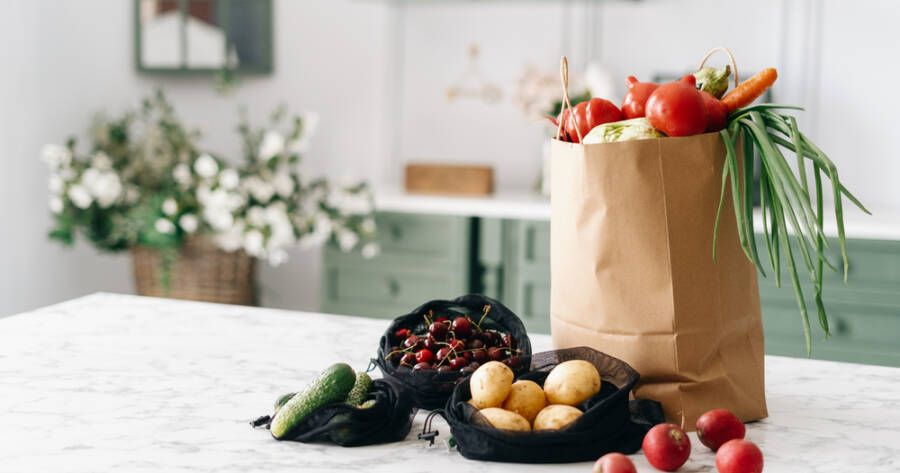A well-stocked kitchen is the heart of every home—but even the best ingredients can lose their flavor, texture, or freshness if stored incorrectly. Surprisingly, many common kitchen staples end up in the wrong spots, leading to wasted food and unnecessary frustration. A few simple tweaks to your storage habits can make your pantry and fridge work smarter, not harder. Ready to keep your go-to ingredients fresher, longer? Explore how to fix the most common storage mistakes.
Tomatoes: Keep Them on the Counter
It’s a common habit to toss tomatoes straight into the fridge, but cold temperatures actually do them a disservice. Chilling tomatoes dulls their flavor and changes their texture, making them mealy instead of juicy. The cold disrupts the ripening process, preventing them from developing their full taste potential.
Instead, store tomatoes at room temperature on your countertop, away from direct sunlight. Keep them stem-side down to minimize moisture loss and bruising. Only refrigerate them once they’re fully ripe and you need to extend their shelf life by a couple of days. Let them come back to room temperature before eating for the best flavor.
Bread: Avoid the Fridge Trap
Many people believe storing bread in the fridge keeps it fresh longer, but the opposite is true. Refrigeration causes bread to dry out and go stale faster due to a process called starch retrogradation. The cold air speeds up moisture loss, leaving your loaf hard and unappetizing.
To keep bread soft and fresh, store it at room temperature in a bread box or a breathable paper bag. For longer storage, freeze slices in an airtight bag and toast as needed. Freezing pauses the staling process without sacrificing texture, ensuring you always have fresh bread on hand without waste.
Onions and Potatoes: Store Separately
It might seem convenient to store onions and potatoes together, but doing so causes both to spoil faster. Onions release gases and moisture that encourage potatoes to sprout and rot prematurely. Meanwhile, potatoes emit moisture that can cause onions to become soft and moldy.
Instead, store onions in a cool, dry, well-ventilated place—like a mesh bag or basket. Potatoes should be kept in a separate, dark area away from light, which prevents greening and sprouting. Keep them both out of the fridge to maintain their ideal texture and flavor for as long as possible.
Coffee: Skip the Fridge and Freezer
Stashing coffee beans or grounds in the fridge may seem like a good idea, but it can compromise their quality. Coffee is highly absorbent and easily picks up moisture and odors from other foods, leading to stale or off-flavors. Temperature fluctuations can also cause condensation, affecting freshness.
The best place to store coffee is in an airtight container, in a cool, dark cupboard away from heat and humidity. This method keeps the beans’ oils and flavors intact, ensuring every cup you brew tastes fresh and aromatic. Only grind as needed to preserve maximum flavor.
Nuts and Seeds: Keep Them Cool and Airtight
Nuts and seeds are packed with healthy fats, but those oils are prone to going rancid when exposed to air, light, and heat. Many people leave them in open containers or on pantry shelves, leading to stale or bitter flavors over time.
To extend their freshness, store nuts and seeds in airtight containers in the fridge or freezer. The cool environment slows down oxidation and keeps them crunchy and flavorful for months. Always bring them back to room temperature before using to maintain their texture and taste.
Flour: Store It Properly to Prevent Pests
Flour is a pantry staple that’s often left in its original paper bag, but doing so invites pests like weevils and doesn’t protect it from moisture. Over time, exposure to air can cause flour to go stale or absorb unwanted odors from your pantry.
Instead, transfer flour to an airtight container as soon as you open it. Store it in a cool, dark place for everyday use, or extend its shelf life even further by keeping it in the fridge or freezer. This keeps it fresh, dry, and ready for baking whenever you need it.
Small Changes, Big Results
A few simple storage tweaks can make a world of difference in keeping your kitchen staples fresher, longer. By rethinking where and how you store everyday items—like tomatoes on the counter or nuts in the fridge—you’ll waste less, enjoy better-tasting food, and save money over time. It’s proof that a little knowledge goes a long way when it comes to making your kitchen work smarter. Your ingredients (and meals) will thank you.

